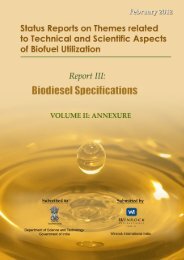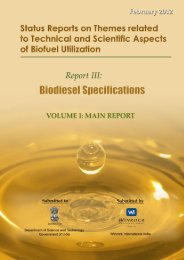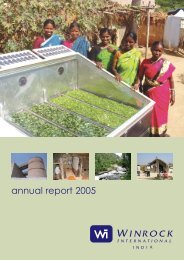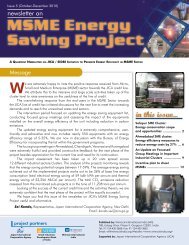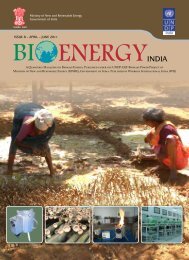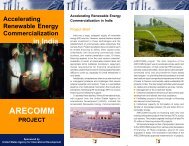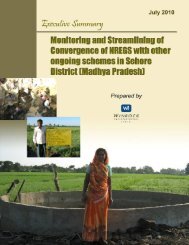ACT Apr-Jun10.p65 - Petroleum Conservation Research Association
ACT Apr-Jun10.p65 - Petroleum Conservation Research Association
ACT Apr-Jun10.p65 - Petroleum Conservation Research Association
You also want an ePaper? Increase the reach of your titles
YUMPU automatically turns print PDFs into web optimized ePapers that Google loves.
advised along with replacement of old<br />
energy inefficient motors with new<br />
energy intensive motors.<br />
Sewage Pumping and<br />
Treatment<br />
Currently, only one sewage treatment plant<br />
(STP) of 25 MLD is in operation for the<br />
ULB and Visakhapatnam being on the east<br />
coast, presently either the treated or<br />
untreated sewage is being let out to sea.<br />
The major observations indentified while<br />
reviewing sewage pumping and<br />
treatment are mentioned in the following<br />
section.<br />
Observations<br />
● Most of the pumps used are very old<br />
with very low level of efficiency and so<br />
there was a requirement of replacement<br />
of old energy inefficient pumps with new<br />
ones. Similarly, energy inefficient motors<br />
need to be replaced with energy<br />
intensive motors.<br />
● Surface agitator type aerators were being<br />
used with large capacity of motors.<br />
● Maintenance cost for rewinding of<br />
motors was very high, as the STP is<br />
located on the beaches of Bay of Bengal<br />
where high moisture levels prevail in<br />
atmosphere.<br />
● The treated sewage was being let out<br />
to sea<br />
Recommendations<br />
● Considering the surface aeration with<br />
compressed air for improving the<br />
Biological Oxygen Demand (BOD) of<br />
the treated sewage was recommended<br />
which would also reduce large size<br />
motors being used for agitating the<br />
sewage water. It would in turn also<br />
reduce the maintenance cost for motors.<br />
● It was also advised to reuse the water<br />
with less than 100 BOD for greenery<br />
instead of letting the same to sea, there<br />
by reducing the usage of sweet water.<br />
The specific energy consumption of<br />
sweet water is more than the energy<br />
consumption for pumping water to tank<br />
trucks.<br />
Street Lighting<br />
There are about 60,000 street lights with<br />
2,628 switching points in 72 wards of ULB.<br />
74% of light fixtures are Fluorescent tube<br />
light (FTL), 14% are 150W High Pressure<br />
Sodium Vapour (HPSV), 7% are 70W SVLs,<br />
3% are 250W High-Pressure Mercury-<br />
Vapor (HPMV) and 2% of them are 250W<br />
& 400 W HPSVs. Street lighting is spread<br />
over 533 sq km of the ULB. The major<br />
observations in this case included:<br />
Observations<br />
● All the cutout controls were without any<br />
protection and were dangerously<br />
installed. In many stretches, even the<br />
spacing between the poles is not<br />
maintained<br />
● Energy meters were not properly<br />
protected / installed.<br />
● Due to multiple fixtures at few junctions<br />
and stretches, zebra effect was observed<br />
and in many areas dark patches were<br />
also observed.<br />
● The overall power factor observed was<br />
very low and it ranged from 0.38 to<br />
0.89.<br />
Recommendations<br />
● It was recommended to replace existing<br />
40W florescent tube with high efficiency<br />
lumen output FTL.<br />
● Providing new control panels with<br />
voltage optimizers, PF compensation<br />
and automatic switching to save energy<br />
was advised.<br />
● It was also suggested to provide<br />
microprocessor controlled automatic<br />
street lighting control including dimming<br />
facility at midnight to early hours and<br />
install automatic timer / photocell unit<br />
for saving energy in lighting system.<br />
● It was also recommended to replace:<br />
i. Existing probe start 250W metal<br />
halide with new 200W energy<br />
efficient pulse start metal halide<br />
including energy efficient control<br />
gear.<br />
ii. Existing probe start 400W MH<br />
lamps with new 320W pulse start<br />
MH lamp including energy efficient<br />
control gear.<br />
iii. Existing electromagnetic control gear<br />
with energy efficient electronic<br />
control gear.<br />
iv. Existing electromagnetic choke with<br />
energy efficient electronic choke for<br />
FTLs.<br />
v. 70W HPSVs with 2x24W T5 FTLs<br />
or LED lighting<br />
Buildings<br />
There are about 516 municipal buildings<br />
including offices, dispensaries, schools,<br />
stadiums, community halls, sulabh<br />
complexes etc. Out of these buildings, 20<br />
buildings were hand picked and audited<br />
through each category of building. The<br />
major observations were:<br />
● Lighting in GVMC Buildings is provided<br />
with incandescent bulbs, FTLs and<br />
CFLs. At the museum, 12V 50W<br />
halogen spot lighting were provided for<br />
the exhibits.<br />
● Standard energy inefficient ceiling fans<br />
and exhaust fans were used in almost<br />
all the buildings.<br />
● Most of the split ACs installed were non<br />
star rated.<br />
Recommendations<br />
● The existing halogen spot light at the<br />
museum was proposed to be replaced<br />
with 12V 35W Infra Red Coated (IRC)<br />
energy efficient spot lights with 500<br />
burning hours, existing incandescent<br />
15<br />
active conservation techniques




